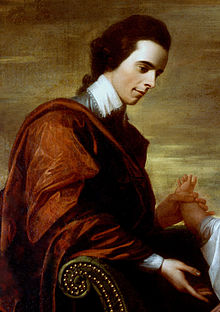Arthur Middleton
| Arthur Middleton | |
|---|---|

Arthur Middleton from a 1771 portrait of the Middleton Family by Benjamin West
|
|
| Born |
June 26, 1742 Charleston, Province of South Carolina |
| Died | January 1, 1787 (aged 44) "The Oaks" near Charleston, South Carolina |
| Resting place | Middleton Place Gardens and Tomb, Charleston |
| Known for | signer of the United States Declaration of Independence |
| Signature | |
Arthur Middleton (June 26, 1742 – January 1, 1787), of Charleston, South Carolina, was a signatory of the United States Declaration of Independence.
His parents were Henry Middleton and Mary Baker Williams, both of English descent. He was educated in Britain, at Harrow School, Westminster School, and Trinity Hall, Cambridge. He studied law at the Middle Temple and traveled extensively in Europe where his taste in literature, music, and art was developed and refined. In 1764, Arthur and his bride Mary Izard settled at Middleton Place.
Keenly interested in Carolina, Middleton was a more radical thinker than his father, Henry Middleton. He was a leader of the American Party in Carolina and one of the boldest members of the Council of Safety and its Secret Committee. In 1776, Arthur was elected to succeed his father in the Continental Congress and subsequently was a signer of the United States Declaration of Independence. Also in 1776, he and William Henry Drayton designed the Great Seal of South Carolina. Despite the time he spent in England, his attitude toward Loyalists was said to be ruthless.
During the American Revolutionary War, Middleton served in the defense of Charleston. After the city's fall to the British in 1780, he was sent as a prisoner of war to St. Augustine, Florida (along with Edward Rutledge and Thomas Heyward Jr.), until exchanged in July the following year.
...
Wikipedia
